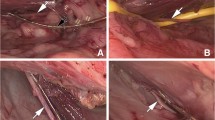Abstract
The aim of this study was to determine gross and neuroanatomic features of a novel periurethral neuromuscular electrostimulator. Periurethral leads were placed in eight female cadavers. In two cases, leads were imaged after placement to enhance anatomic understanding. Pelvic viscera were removed en bloc for analysis of lead placement in the six remaining cadavers. Excised tissue was sectioned and immunostained to identify general, afferent, sympathetic, and nitric oxide synthase efferent nerve fibers. The electrodes were found within/lateral (n = 4), within/posterolateral (n = 9), and anterolateral (n = 1) to the external urethral sphincter (distance 0.25 ± 0.5, 2.9 ± 3.3, and 1.0 ± 0.0 mm, respectively). The electrode to the urethra and vagina distance averaged 7.6 ± 3.4 and 8.8 ± 4.3 mm, respectively. Variable density staining for all nerve types was found around the electrode. A periurethral electrode interfaces the external urethral sphincter, and the adjacent distribution of nerve fibers supports proposed neuromuscular therapeutic mechanisms.




Similar content being viewed by others
References
Kelleher CJ et al (1997) A medium-term analysis of the subjective efficacy of treatment for women with detrusor instability and low bladder compliance. Br J Obstet Gynaecol 104(9):988–993
Nissenkorn I, De Jong PR (2005) A novel surgical technique for implanting a new electrostimulation system for treating female overactive bladder: a preliminary report. BJU Int 95(9):1253–1258
Nissenkorn I et al (2004) Patient-adjusted intermittent electrostimulation for treating stress and urge urinary incontinence. BJU Int 94(1):105–109
Shafik A (1999) A study of the continence mechanism of the external urethral sphincter with identification of the voluntary urinary inhibition reflex. J Urol 162(6):1967–1971
Parsons M et al (2006) Analysis of long-term pelvic floor electrostimulation therapy for interstitial cystitis. Eur Urol Suppl 5(2):193
Kenton K et al (2007) Aging and overactive bladder may be associated with loss of urethral sensation in women. Neurourol Urodyn 26(7):981–984
Geirsson G, Fall M (1999) Reflex interaction between the proximal urethra and the bladder. A clinical experimental study. Scand J Urol Nephrol 33(1):24–26
Garry R, Roberts T, Todd J (1959) Reflexes involving the external urethral sphincter in the cat. J Physiol 149:653–665
Conflicts of interest
James L. Whiteside, Kathy M. Ensrud-Bowlin, and Kenneth P. Roberts are paid consultants with American Medical Systems.
Author information
Authors and Affiliations
Corresponding author
Rights and permissions
About this article
Cite this article
Whiteside, J.L., Ensrud-Bowlin, K.M., Wang, G. et al. Lead placement and associated nerve distribution of an implantable periurethral electrostimulator. Int Urogynecol J 20, 325–329 (2009). https://doi.org/10.1007/s00192-008-0776-7
Received:
Accepted:
Published:
Issue Date:
DOI: https://doi.org/10.1007/s00192-008-0776-7




